- Bees
- Chickens
- Cows
- Deer
- Donkeys
- Elephants
- Frogs
- Geese
- Horses
- Lobsters
- Pigs
- Rabbits
- Rats
- Seals
- Sheep
- Turkeys
Horses

The horse (equus ferus caballus) belongs to the Equidae family, which includes horses, donkeys and zebras.
The only real wild horse species that is still in existence is the Przewalski's horse (equus ferus przewalskii). It can be pronounced as "sheh-VAHL-skee", "per-zhuh-VAHL-skee" or "PREZ-VAHL-skee". The Przewalski horse was named after the Russian geographer and explorer Colonel Nikolai Przhevalsky (Polish name Przewalski), and is the closest living relative of the domestic horse. The Przewalski's horse is also known as the Mongolian wild horse, the Asiatic wild horse or even simply as P-horse.
Other horses living in the wild are descendants of once-tame animals and are known as feral horses. True wild horses generally have an erect mane and no forelock (fringe), whereas domesticated horses have a hanging mane and forelock. You can find some Przewalski's horses with a hanging mane, which indicates that they were crossed with a domesticated mare when breeding first started.

The only other wild horse that was never domesticated was the Tarpan horse, also known as the European Wild Horse. This horse was found in both Europe and Asia and became extinct in 1909.
To estimate when domestication first took place and how the domesticated horse spread, scientists have used archaeological and palaeological discoveries and also compared DNA, obtained from modern horses to that from bones and teeth of ancient horse remains. Horses were most likely first domesticated in central Asia prior to 3500 BC. Emperor Fo Hi is said to have introduced domesticated horses in China in 3468 BC. Around 1400 BC, the domesticated horse was used by the Hittites as a draft animal for their chariots. The domesticated horse was not introduced in Europe until several hundred years later.

A foal is a horse of either sex, less than one year old. The term "suckling" is sometimes used to describe a nursing foal and "weanling" to describe a foal that has been weaned.
A colt is a male horse younger than four years of age. A stallion is a non-castrated male horse older than four years of age. A gelding is a castrated male horse of any age.
A filly is a female horse younger than four years of age and a mare is a female horse older than four.
Horses are able to crossbreed with other members of their genus. A mule is a cross between a male donkey and a female horse. A hinny is a cross between a female donkey and a male horse. A zorse or zebroid is a cross between a zebra and a horse. Most of these hybrids are sterile and unable to reproduce.
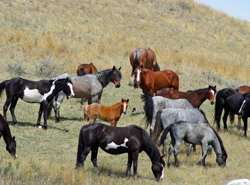
In the wild, horses live in social structures. Herds consist of family groups, each containing one stallion, one or more mares and their foals. Group sizes range from 2 to about 20 horses.
Family groups are usually permanent associations. A stallion and his mares stay together their entire lives. When the family stallion is old or sick he sometimes leaves or is driven away. When the stallion dies, another stallion takes over the mares. If the new stallion already has his own family, the two families will merge into one group.
Each family group has a dominant mare, who decides which direction the group takes, which watering holes they will visit and how long they will stay at a certain spot to graze. The stallion stays at the back of the herd, but sometimes also takes lead, especially when they travel over dangerous terrain.
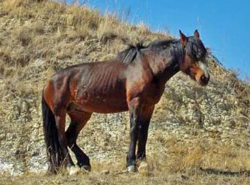
Social grooming is generally only done with other horses in the same family and only the family stallion is allowed to mate with his mares.
Young mares leave the family when they are one to two years old, when a stallion selects her, or sometimes when she selects a stallion.
Young stallions leave the family when they are one to four years old. Some stallions never start a family or reproduce and live together in stallion groups, which can include the same members for many years.
The leaving of the family by the young mares and stallions prevents both inbreeding and the group from becoming too large.
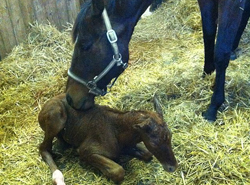
In the wild, mares are capable of reproduction at two and a half years, stallions at four to five years of age.
A mare can have one foal a year, until she is around 20 years or older. The gestation period lasts about a year. When foals are born, they will come out head first, enclosed by the embryonic membrane. They will break this by shaking themselves. Foals are able to stand after about 20 minutes and will start walking after about an hour.
Mares will lick their foals all over their bodies, to create the first maternal bond. It will take about a week however, for foals to recognize their mothers. The first week, foals will follow basically any moving object that's bigger than themselves. For this reason, mothers will chase away any other creatures that try to come close to their foals, by threatening to bite them. This helps the foal to recognize their mother. Once they recognize her, they are able to tell her apart from hundreds of other horses.
Foals are weaned at 8 to 10 months of age.
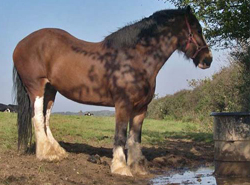
Horses are warm-blooded animals. However, the terms "hot blood", "warm blood" and "cold blood" are used to describe different breeds of horses that share certain characteristics.
"Hot blooded" breeds are oriental horses that originated from the Middle East and Northern Africa. They are mostly bred for their agility and speed and include horses like the Arabian horse, Akhal-Teke and Thoroughbred.
"Cold blooded" horses originate from the colder, northern regions of the world. They are usually more muscular horses who are bred for their strength. They include the breeds: Abtenauer, Belgian Draft, Clydesdale, Haflinger, Percheron and Shire.
"Warm blooded" horses are the most common type of horse. They are not necessary a cross between a "cold blood" and a "hot blood". They originated primarily in Europe and were bred in different countries depending on what they were used for. There are also American and Asian "warm blooded" breeds. They include the breeds: Hanoverian, Holsteiner, Lipizzaner, Oldenburg and Mustang.
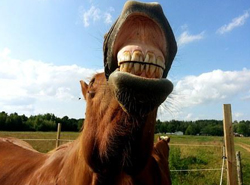
Male horses have between 40 and 42 permanent teeth, whereas female horses have between 36 and 40 teeth.
Like humans, horses have two sets of teeth in their lifetimes. Their first baby teeth erupt before they are born or shortly afterwards. They will have all their baby teeth at the age of about eight months. The baby teeth are replaced by adult teeth between the ages of 2 1/2 and 5.
The high content of silicic acid in grasses causes a lot of wear on the teeth. This is offset by a continuous growth. This continued growth and wear helps in using a horses teeth to determine their age. Factors like grazing conditions or genetics can influence the condition of a horse's teeth, making this not an exact science.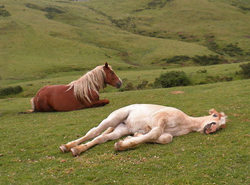
Horses are herbivorous mammals. In the wild, they eat mainly grasses and sometimes leaves and bark. They spend about 50% of their days looking for food.
Horses have symbiotic microorganisms in their gut which helps to break down plant cellulose. To obtain these essential microorganisms, young colts often eat the feces of another horse, usually of their mother, the first days after being born. Horses also ingest soil to obtain important minerals missing from their diet.
Horses can rest both standing or lying down. To rest while standing, they droop their head, turn their ears sideways, slowly move their tail from side to side and keep their eyes half closed. When they lie down, adult horses often rest with their legs underneath them, so they can jump up right away. Younger horses often extend their legs away from their bodies and lie flat on the ground. Members of the group never all sleep at once, but take turns standing watch.
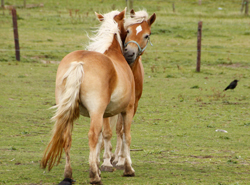
Horses rub themselves against trees to get rid of loose hair, dandruff, insects or other foreign bodies. They can also scratch themselves on the head and neck with their rear legs. Other ways of ridding themselves of insects include beating them with their tails, shaking themselves or by twitching the skin on the place where the insect is bothering them.
Horses groom each other not only to stay clean, but also as an important social function and as part of the foreplay ritual in mating.
When they greet each other, they touch noses and then sniff other parts of the body, especially around the tail area. They also often press their bodies together and lie their head on the other horse's back. When horses of equal rank touch noses, they will bring their ears forward. A horse of lower rank will lay the ears back.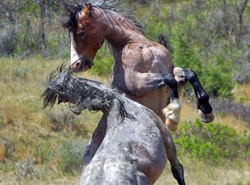
Horses have different methods of fighting. One method is by circling each other and by trying to bite the other's legs. They also fight by raising their head and by trying to press the other's head down.
Their toughest fighting method is by both standing on their hind legs while striking out with their forelegs. While doing this, they will try to attack the opponent with their teeth. The main purpose of these attacks is not to injure the other horse, but to make him lose his ballance. The one who falls first has lost and will flee.
Mares and foals generally fight by turning away from their opponents and by kicking them with their hind legs. They also use this method to defend against predators.
Enemies of horses include lions, hyenas, wolves and humans.
Horses are not territorial. They can peacefully share a range with animals of their own or other species.
Horses enjoy playing. Foals often play by running around their mothers in circles. Colts and young stallions enjoy engaging in mock fights. They will fight each other, but with less force.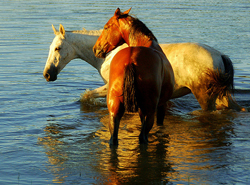
Horses have a very good sense of direction. Domestic horses have been know to be able to find their way on a path that they've only been on once many years prior. Wild horses sometimes travel more than 60 miles, before returning to the same spot, even by different routes.
All members of the horse family are capable of swimming. Swimming is a very exhausting exercise for a horse and some horses are either afraid of water or can suddenly panic. Experts have also determined that horses are unable to turn while treading water. This will cause them to swim in a straight line and has led to horses drowning.
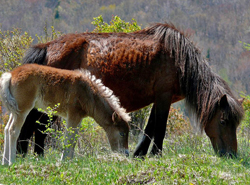
The life expectancy of the domestic horse is about 25 to 30 years. They occasionally live longer. The oldest verifiable horse is known as "Old Billy". He lived in the 19th century and reached an age of 62.
A pony is a small horse. Whether an animal is considered or horse or pony is determined by their size, their temperament and their physical make-up.
Horses are creatures of the open terrain. In a maze they are totally lost and far inferior to a rat.
Horses have the largest eyes of any land animal.



